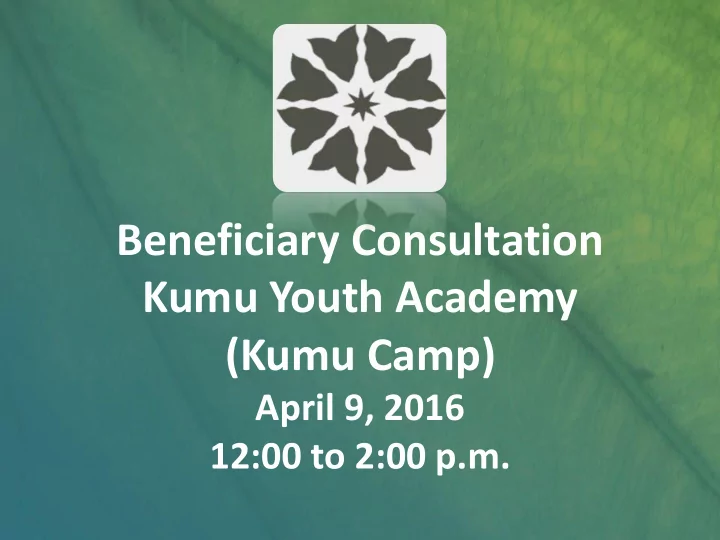

Beneficiary Consultation Kumu Youth Academy (Kumu Camp) April 9, 2016 12:00 to 2:00 p.m.
Agenda I. WELCOME AND INTRODUCTIONS – Introductions – Meeting Format and Review of Agenda – Group Kuleana (Ground Rules) II. WHY WE ARE HERE TODAY – Trigger for Beneficiary Consultation – Purpose for Consultation — What we want to know – How Will the Beneficiary Input Be Used? III. INFORMATION ABOUT THE SITE III. INFORMATION ABOUT THE PROJECT IV. PRESENTATION ON KUMU CAMP BY AHHA/HCDC V. QUESTIONS/ANSWERS, COMMENTS AND CONCERNS VI. NEXT STEPS
DHHL Beneficiary Consultation • Policy of Consulting Beneficiaries for: – Land Use Projects – Long-Term Leases/Licenses • Consultation Meeting – Who are we Consulting? – What’s Being Proposed? – Do the Beneficiaries Support the Project? – Will the Project Provide Benefits for Beneficiaries? – Record Input • One-Month Consultation Period – Receive Written Comments (email, mail, phone) • Consultation Report to HHC – Who Came to the Meeting – Summarize Main Points – Attach Full Record of Comments – Recommend Acceptance of the Report • Other Divisions Make Recommendations for Action
Meeting Purposes Conduct DHHL Beneficiary Consultation Present Project background information Assess level of Beneficiary support for the Project
Meeting Outcomes At the end of today, we will have: Shared understanding of the Kumu Camp Project List of the Project’s social, cultural & economic benefits to you and to HHCA beneficiary community Indication of the level of DHHL Beneficiary support for the Kumu Camp Project
SOCIAL CAPITAL is… the features of social organization, such as networks, norms and trust, that facilitate coordination and cooperation for mutual benefit.
HOW IT IS CREATED?? THROUGH Individual behavior that reflects trust & reciprocity (volunteering, interacting across social/demographic divides, open communication with others, sharing tools) AT Community venues (potlucks, volunteer events, block parties, festivals, parks, clubs) BY HAVING Community institutions (accurate newspaper, engaging radio station, accessible local government, schools, community centers)
Examples of Social Capital INDICATORS Good attendance at public meetings Active involvement in local organizations Communication & coordination among community organizations Acceptance of different opinions Ability to mobilize diverse resources Diverse & inclusive local networks Good connections to regional, state and national resources
DHHL Anahola Lands Anahola Homesteads Approximately 4,500 acres 535 Residential & 46 Agriculture Lessees (21% of Kaua‘i lands) On Deck: Pi‘ilani Mai Ke Kai 267 Subsistence Agriculture
Historical Overview TIMEFRAME ACTION 2004 Kaua‘i Island Plan- designates (zones) site as “Special District” and “Community Use” 2010 Anahola Regional Plan identifies a “potential project” for a “ Kumu Academy” retreat for Hawaiian organizations, cultural practitioners, kumu and homesteaders around the base of Anahola River. -- DHHL issues AHHa/HCDC a Month-to-Month Revocable Permit for the Site 2011 -- AHHA/HCDC Cleans Area, Installs Tentalos and Portable Lua, etc. -- AHHA/HCDC Starts to Host Youth Groups -- AHHA/HCDC Submits Land Use Request for the Site 2012 -- AHHA/HCDC Publicize that Kumu Camp is Open for Business 2013-2015 -- AHHA/HCDC Secure Grants for Improvements -- Hires a Planning Firm to Prepare an Environmental Assessment (EA) Oct. 2015 HHC Workshop on Draft EA — HHC requests additional due diligence Dec. 2015 Staff Conducts Site Visit and Holds Meetings with State and County agencies Jan. 2016 HHC Issues a Finding of No Significant Impact for the EA
Site Information KUMU CAMP 5 acres of 8-acre Parcel
History of Kumu Camp HCDC/AHHA will discuss history of drug use and need to develop a project for a youth and kupuna camp to serve the needs of Anahola Homestead Community.
History of Kumu Camp Discuss Cultural resources in Anahola Bay need to educate youth about culture and history of the Bay Discuss youth activity programs number of youth and homesteaders served over the years.
History of Kumu Camp Discuss facilities available for youth camping activities, number of structures, capacity of camp and individual camping units, discuss maintenance and management.
History of Kumu Camp Discuss schedule of youth and other cultural activities, explain how homesteaders can use the facilities, fee schedule (homesteaders and non homesteaders) described activity uses overnight visitors
Disposition requirements • Obtain DOH Approval for Waste Water System • Report results of Consultation to HHC • Finalize authorized uses based on approved FONSI and incorporate into disposition • Incorporate recommendations from Beneficiary Consultation
Next Steps and Timeline DHHL Beneficiary Consultation Today – April 9, 2016 30-day comment period May 9, 2016 DHHL prepares Beneficiary May 10 – June 1, 2016 Consultation Report DHHL prepares HHC submittal for June 2, 2016 Land Disposition, includes Beneficiary Consultation Report & Flow Chart Criteria HHC Commission meeting June 20 – 21 / Kapolei
Activity: discussion groups Breakout in groups organized by: HHCA Beneficiaries: Applicants, Lessees, Successors Non-HHCA Beneficiaries
Discussion Questions 1) What do you see are the social, cultural & economic benefits to you and your community? 2) On a Scale of 1 to 5, how strongly do you support this Kumu Camp project? 1 —don’t support/weak support 3 — not sure 5 — strong support
Recommend
More recommend